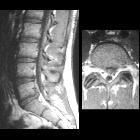disc bulge
A disc bulge represents displacement of the outer fibers of the annulus fibrosus beyond the margins of the adjacent vertebral bodies, involving more than one-quarter (25% or 90 degrees) of the circumference of an intervertebral disc . Because it is limited by the annulus fibrosus it does not extend above or below the attached margins of the disc . Disc bulges, along with vertebral endplate bowing, are responsible for the disc height loss that is seen with aging.
Terminology
Disc herniation is distinguished from a disc bulge in that it involves less than 25% of the circumference.
NB: A number of definitions of what exactly constitutes a disc protrusion have been proposed/used over the years, and it is important to realize that these differ substantially from one another . At the time of writing (June 2020) the most recent and widely used terminology was proposed in 2014 by Fardon et al, and represents a consensus of the North American Spine Society, the American Society of Spine Radiology and the American Society of Neuroradiology .
Classification
Bulges are always broad, and can be further divided according to how much of the circumference they involve:
- circumferential bulge: involves the entire disc circumference
- asymmetric bulge: does not involve the entire circumference, but nonetheless more than 90 degrees
Practical points
Bulging is an observation of the contour of the outer disc, and it is not a specific diagnosis. Bulging has been ascribed to redundancy of the annulus, loss of disc space height, ligamentous laxity, response to loading or angular motion, and remodeling in response to adjacent pathology, and volume averaging on CT/MRI axial images. It has also been ascribed to unrecognised and atypical herniated discs. Discs that are known to be herniated should be diagnosed as herniations (or specific types of herniations) .
Siehe auch:
und weiter:

 Assoziationen und Differentialdiagnosen zu disc bulge:
Assoziationen und Differentialdiagnosen zu disc bulge:

